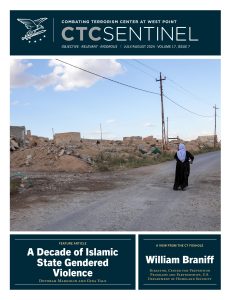From the Director
Ten years ago, in August 2014, the Islamic State began its genocidal campaign against the Yazidi community. In our cover article, Devorah Margolin and Gina Vale evaluate how the group’s gendered violence has manifested during and after its caliphate years. “Even without its caliphate,” they write, “the Islamic State’s gendered violence continues, as its supporters and ideology remain. Arguably, the lack of timely and appropriate responses has perpetuated this violence.”
Our interview this month is with William Braniff, director of the Center for Prevention Programs and Partnerships at the Department of Homeland Security. In it, he describes his office’s efforts to utilize a public health-informed approach to preventing targeted violence and terrorism.
Edward Lemon and Noah Tucker examine Central Asians’ prominent role in recent global terror plots and attacks. They argue that analysis should focus more on “the factors that led to mobilization to Syria and Iraq a decade ago and that have been exacerbated in recent years, especially in Tajikistan, including crackdowns on religion, corrupt ineffective governance, high levels of migration, and well-established terror networks that are holdovers from the peak of the Islamic State” as a way to understand this evolving threat area.
When news reports appeared earlier this summer suggesting that the leader of the Islamic State in Somalia, Abdulqadir Mumin, may have quietly become the “worldwide leader” of the Islamic State last year and may have been killed in a recent U.S. airstrike, the news created far more questions than answers. Austin Doctor and Gina Ligon take a nuanced look at what the developments—if true—could mean for the group.
Jessica Davis provides analysis of the Islamic State’s post-caliphate financial strategies. “The future of the Islamic State’s financial infrastructure,” she writes, “is networked, resilient, and adaptive.” This reality, she warns, portends “a grim future for efforts to combat the group’s international presence.”
Finally, in June, the U.S. State Department designated the Nordic Resistance Movement, the largest neo-Nazi group in Sweden, as a Specially Designated Global Terrorist, only the second white nationalist organization on its terrorist list. Peter Smith outlines the development of the group and considers what the designation could mean for its future.
Colonel Sean Morrow, Director, Combating Terrorism Center
 Skip to content
Skip to content

